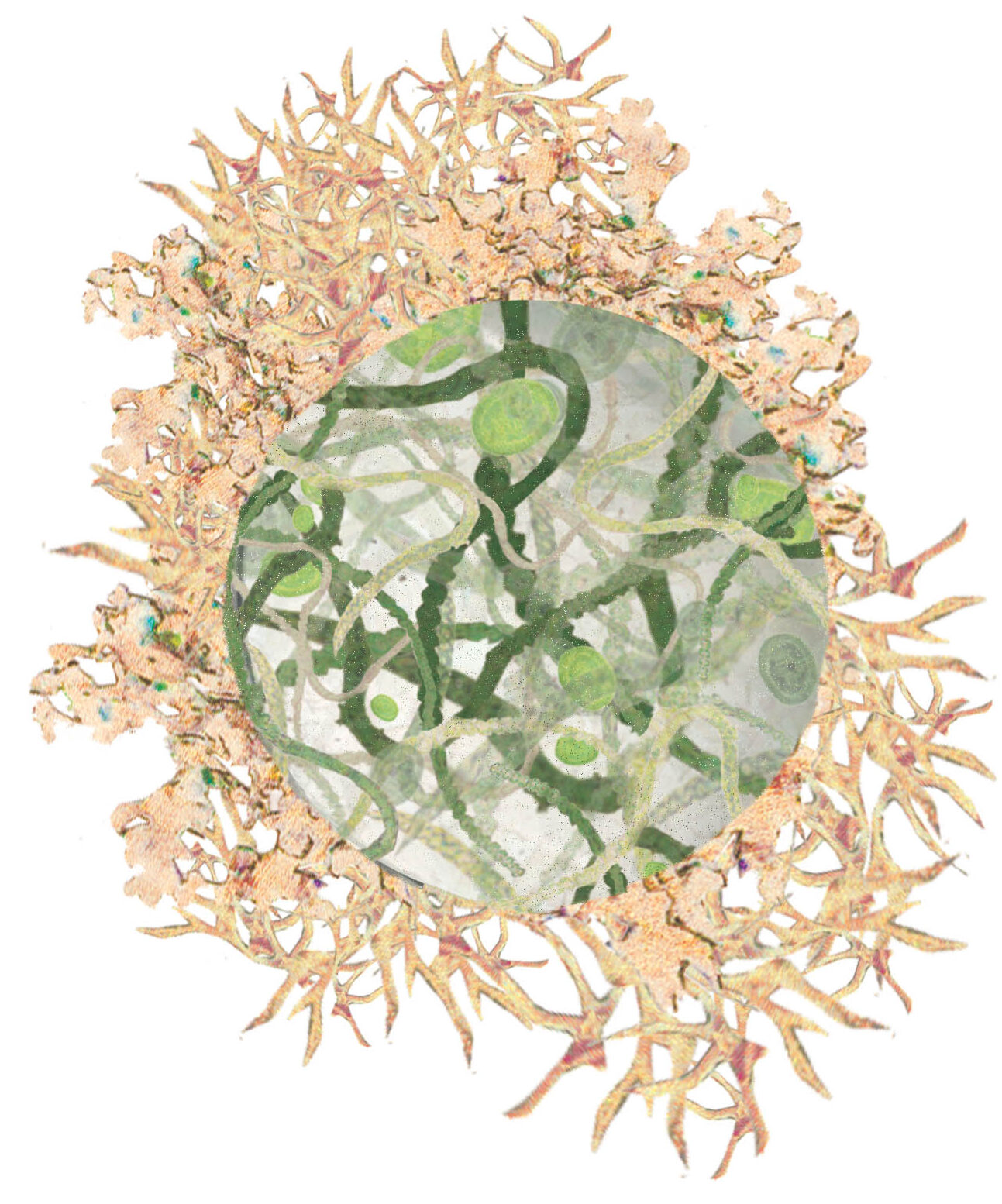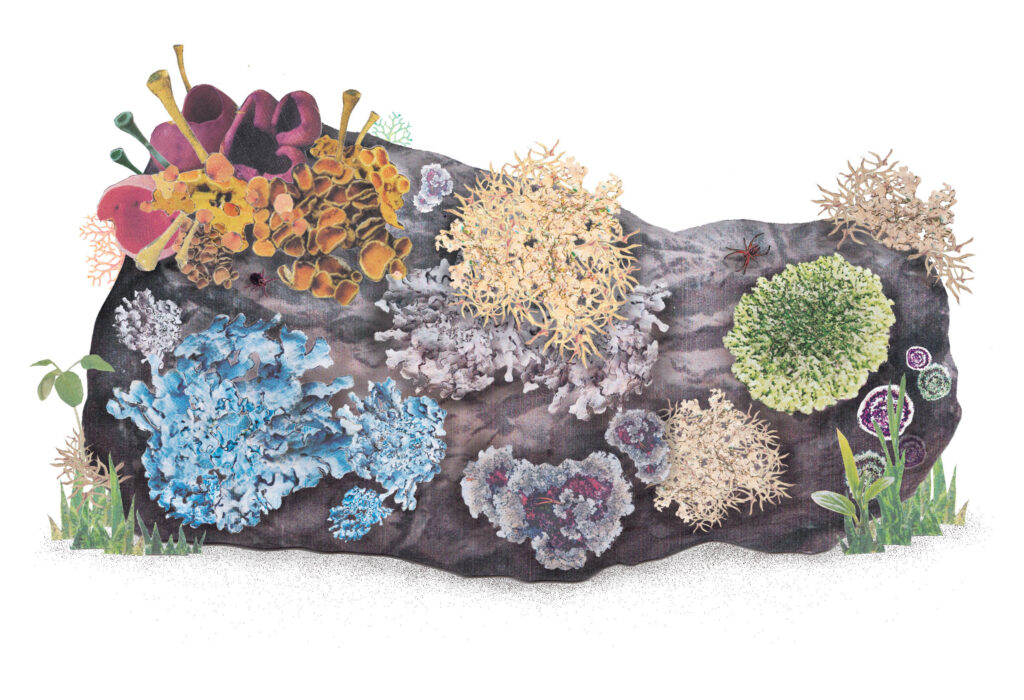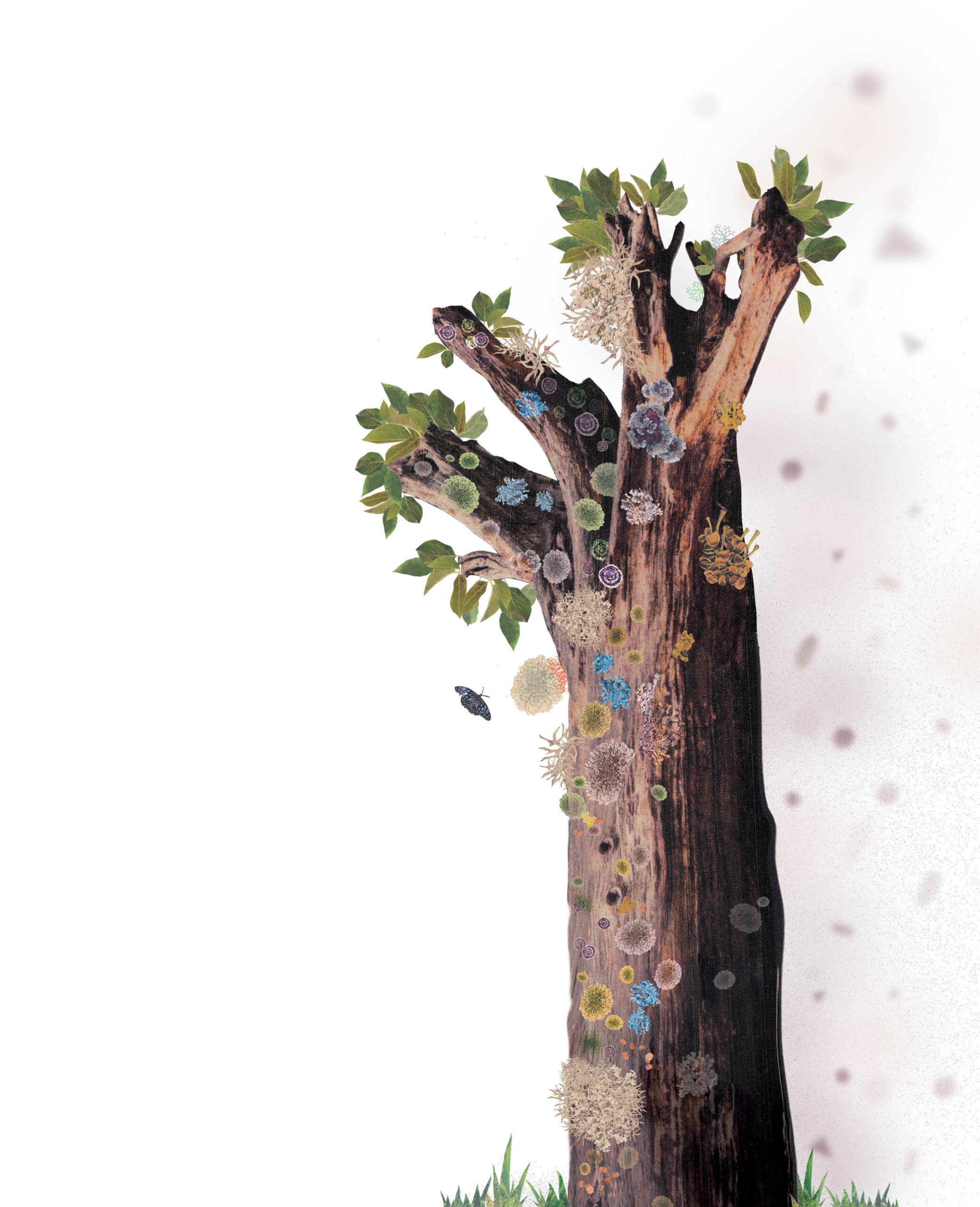You might have noticed lichens growing on trees, or rocks, or soil, in both rural and urban environments. These relatively small but beautiful organisms can be powerful bioindicators used to monitor, manage, and reverse environmental harm in the transition to a more sustainable future.
Lichens are sometimes referred to as ‘mini-ecosystems’. This is because they are not one thing but composed of at least two functionally different partners that coexist in regulatory balance. One partner—an alga or a cyanobacteria—is a primary producer, using photosynthesis to create sugars for food. The other partner—a fungus—is a consumer, harvesting some of this food production to meet its own energy requirements. The consumer fungus creates the structure of the lichen (the ‘thallus’), within which it protects the primary producer from harm, be that herbivores or excess light. Lichens are therefore created by fungi that have evolved this specialist mode of nutrition, and different lichens represent different fungal species.

A key feature of lichens is that they are very sensitive to ambient environmental conditions. When conditions are wet, they hydrate and become physiologically active. When conditions are dry, they desiccate and become physiologically dormant. They also absorb atmospheric nutrients to meet their mineral requirements. This ability to live independently of the soil, by accessing water and sequestering nutrients from the surrounding air, or rainfall, allows lichens to live in extreme habitats, such as on the surface of rocks, or attached to tree-bark as epiphytes.
Ecologically successful, lichens can be found from the tops of the highest mountains to the seashore, and from tropical rainforests to deserts. However, their intimate connection with the surrounding environment also creates a vulnerability. As well as allowing lichens to colonise into extreme habitats where few other organisms can survive, they are rendered extremely sensitive to changes in the wider chemical environment, including the effects of pollution.
The global pollution problem
Pollution—waste from human consumption unsustainably emitted—is not a new problem. Lead pollution from Roman metallurgy can be detected in peat and lake cores across northern Europe and is thought to have increased human mortality rates at that time. However, particularly since the industrial revolution, the environmental damage from pollution has accelerated. Pollution is now identified as one the major drivers of biodiversity loss and ecosystem harm worldwide, along with habitat loss, climate change, and invasive species.
Arguably, one of the planet’s greatest problems is nitrogen pollution. The invention of the Haber-Bosch process in the early 20th century allowed the industrial production of ammonia, including for chemical fertilisers that supply extra ‘reactive nitrogen’ (Nr) to remove key limits on plant growth, fuelling the ‘green revolution’. Despite clear success in feeding the global population, on average about only half of the Nr supplied as either natural (slurry) or industrial fertiliser is taken up by crops, with the rest leaked into the wider environment as air or water pollution.
This excess nitrogen kills sensitive species and simplifies ecosystems. It’s also a precursor to atmospheric particulate matters (PM2.5 and PM10) that are estimated to contribute to approximately 7 million excess human deaths annually, and overall results in a global economic cost estimated at US$200-2,000 billion per annum in terms of environmental remediation.
Can lichens help?
Lichens sequester nitrogen directly from atmospheric sources in solution or as dry deposition, and different lichen species are adapted to contrasting levels of nitrogen. On this basis, the types of lichen that are found at a given location can be used as bioindicators to assess how much nitrogen is present.
The sensitivity of some lichen species makes them excellent indicators of emerging ecosystem harm, measured as the point at which these lichens are negatively impacted by nitrogen.
For example, 1 μg of ammonia per cubic metre of air has been used to set a ‘critical level’ for monitoring and managing nitrogen air pollution in the UK and Europe (for context, the concentration around a poultry farm may reach up to 60 μg of ammonia per cubic metre of air). In this way, lichens can help to make invisible air pollution visible. As such, lichens are a powerful tool for citizen science and wider public education.

Research in many temperate regions (including Europe and North America) has helped to establish critical levels (concentration limits) and critical loads (deposition limits) around which to regulate and control nitrogen pollution. However, the nitrogen problem has swung towards the tropics. In South Asia, the Indo-Gangetic Plain in northeastern India is where global nitrogen pollution is accelerating most rapidly at 2–7 percent per annum based on trends for 2000–2015, and it already has among the highest concentration of ammonia globally.
The wider South Asia region is a biodiversity hotspot as well as home to approximately 1.9 billion people, posing the risk that if nitrogen pollution continues unabated then nature-based socio-economic structures could collapse. To address this problem, the UK Research and Innovation South Asian Nitrogen Hub (SANH)—which aims to reduce regional nitrogen pollution for the benefit of people and nature—sought to establish a robust set of critical levels and critical loads for the South Asian tropics, based around the use of lichens as bioindicators.
The deeper relevance of using lichens as bioindicators within South Asia is that they are also a commercially important non-timber forest product, being traded into the perfume industry, as well as having wider cultural value—as a source of food and medicine, and for ritual symbolic purposes.
New evidence
To better understand the sensitivity of tropical lichens to nitrogen, the SANH team generated a new experimental platform in which ammonia was released into a forest plot, creating high concentrations close to the source, and diminishing to background concentrations within 30–40 metres. Under close control depending on the weather conditions, it was possible to generate a predictable plume of ammonia along which lichens could be monitored, and into which lichens could be translocated, and their response measured.
Tested initially for a site close to Edinburgh in Scotland, with help from the Dilmah tea company, the experimental platform was recreated in an upland tropical forest in Sri Lanka. In a first ever direct comparison across temperate and tropical zones, the paired sites are now revealing how the combination of nitrogen dose and exposure period affect lichen physiology, and cause changes in lichen diversity for a tropical forest.
This research has several important repercussions. A benchmark SANH report, Nitrogen Pollution in South Asia: Scientific Evidence, Current Initiatives and Policy Landscape, reviewed 966 policy instruments operative in 2019 and concluded: “South Asian nitrogen-related policies are typically qualitative in nature and rarely set quantitative targets for reduction. Very few policies try to manage pollution in a measurable way.”
The new data generated for tropical lichens by SANH can be used—as has been the case in the UK and Europe—to provide the quantitative targets (critical levels and critical loads) around which the regulation and management of nitrogen can be formulated. However, nitrogen monitoring is also essential to achieve adaptable and goal-orientated nitrogen management.
Monitoring capacity is limited in South Asia, which has only 2 percent of the capacity delivered in the UK by the National Ammonia Monitoring Network, despite it being a region that is far larger and more geographically complex. Here again, the lichens can help. Having created a better understanding of the nitrogen response of lichens in the region (which species are more or less sensitive to excess nitrogen), they can be used as bioindicators to monitor nitrogen levels, and assist with mapping and managing nitrogen pollution in South Asia. To this end, the experimental studies paired between sites in Scotland and Sri Lanka are complemented by field-based monitoring of lichens for different climatic regions of the Himalayas, in Pakistan, Nepal, and Bhutan.
Lichens matter
There are about 30,000 species of lichen-fungi globally, contributing to the Earth’s extraordinary biodiversity. They operate in symbiosis as primary producers, providing food for animals that scale from mites to caribou. They create habitat structures for invertebrates, which in turn support bird populations. They sequester and process atmospheric water and nutrients, and the lichens with cyanobacteria can ‘fix’ nitrogen directly from the atmosphere, rather like the nodules of legume roots.
As described for this regional South Asian case study, lichens can be both commercially and culturally important. They are also vulnerable to habitat loss, to climate change, and to pollution. However, as demonstrated here for nitrogen, the vulnerability of lichens can be characterised and used to bolster our efforts to become more aware of and to reverse environmental harm.
Further Reading
Cape, J.N., L. J. van der Eerden, L. J. Sheppard, I. D. Leith and M. A. Sutton. 2009. Evidence for changing the critical level for ammonia. Environmental Pollution 157: 1033–1037.
De Vries, W. 2021. Impacts of nitrogen emissions on ecosystems and human health: A mini review. Current Opinion in Environmental Science and Health 21: 100249.
Sutton M.A., N. van Dijk, P. E. Levy, M. R. Jones, I. D. Leith, L. J. Sheppard, S. Leeson et al. 2020. Alkaline air: changing perspectives on nitrogen and air pollution in an ammonia-rich world. Philosophical Transactions of the Royal Society A 378: 20190315.






